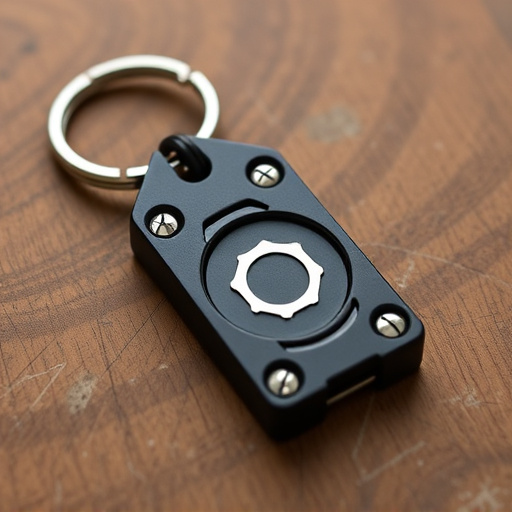In today's fast-paced world, personal safety is a growing concern, leading to the need for compact, effective, and discreet self-defense tools. Traditional options often lack practicality for everyday carry. To address this, designing a successful keychain defense tool requires using rust-proof materials like stainless steel for durability and reliability in various environments. Balancing size, effectiveness, and safety features ensures a versatile, ergonomic, and legally compliant self-defense option, prioritizing user safety and comfort.
In today’s world, personal safety is paramount. This compact keychain defense tool caters to the growing demand for discreet yet effective self-defense solutions. By combining innovative design with robust materials, we present a durable and versatile option that fits seamlessly into daily life. This article explores the key aspects behind creating an ideal self-defense device, focusing on rust-proof materials as a cornerstone of durability. We delve into design considerations, safety features, and legal implications to ensure responsible use.
- Understanding the Need for Compact Self-Defense Tools
- Choosing Rust-Proof Materials: The Foundation of Durability
- Design Considerations for Optimal Carry and Functionality
- Safety Features and Legal Implications: Ensuring Responsible Use
Understanding the Need for Compact Self-Defense Tools
In today’s fast-paced world, personal safety is a growing concern for individuals across various demographics. The need for compact self-defense tools has become increasingly evident as people seek effective yet discreet ways to protect themselves in public spaces. Traditional self-defense options often prove cumbersome and impractical for everyday carry, leading many to overlook their preparedness until it’s too late.
A key consideration in designing a successful compact keychain defense tool is the use of rust-proof materials. Rust-resistant metals like stainless steel ensure longevity, allowing users to rely on their device for years without concern for structural failure or performance degradation. This focus on durable, high-quality materials is crucial, especially when aiming to create a reliable and accessible self-defense solution that fits comfortably on a keychain.
Choosing Rust-Proof Materials: The Foundation of Durability
When designing a compact keychain defense tool, one of the most critical considerations is selecting rust-proof materials to ensure longevity and reliability. In the world of self-defense tools, durability is paramount; your device should be able to withstand the test of time and various environmental conditions. Materials like stainless steel are renowned for their rust resistance, making them an excellent choice for such tools. This robust metal can maintain its integrity in humid or wet environments, ensuring your keychain defense tool remains functional when you need it most.
Choosing rust-proof materials goes beyond just the tool’s effectiveness; it also dictates the overall maintenance and care requirements. Tools crafted from these durable substances demand less frequent replacement and reduce the need for costly repairs. In summary, for a compact keychain defense tool that offers reliable self-defense capabilities, investing in rust-proof materials is essential to create a long-lasting and dependable companion.
Design Considerations for Optimal Carry and Functionality
When designing a compact keychain defense tool, considerations for optimal carry and functionality are paramount. The key is to strike a balance between size and effectiveness. Materials play a crucial role; opting for rust-proof, durable options ensures the tool remains reliable in various environments. High-quality stainless steel or titanium alloys are excellent choices due to their resistance to corrosion and ability to withstand frequent use.
Functionality should be intuitive and easy to deploy. A smooth, secure locking mechanism is essential for peace of mind. Incorporating features like a sharp edge or a striking surface increases the tool’s versatility. Additionally, considering ergonomic designs can make it easier to grasp and control during emergencies. Prioritizing these aspects results in a compact defense tool that offers both convenience and security, appealing to users seeking effective self-defense options.
Safety Features and Legal Implications: Ensuring Responsible Use
When designing a compact keychain defense tool, safety features should be paramount. The primary material choices, such as rust-proof, high-quality steel, ensure durability and longevity while minimizing the risk of injury. This is crucial for users who might need to defend themselves in various environments, from urban streets to outdoor adventures. Additionally, incorporating anti-rebound mechanisms and ergonomically designed grips can significantly enhance safety by preventing accidental harm to the user or bystanders during use.
Legally, the responsible use of self-defense tools is governed by local regulations. It’s essential for manufacturers and users alike to stay informed about legal implications, including restrictions on certain types of weapons and age limitations for possession. Designing with these considerations in mind, such as employing non-lethal force options and adhering to size and capacity limits, helps ensure that the compact keychain defense tool remains within legal boundaries while still offering effective protection.
In light of the growing demand for personal safety, a compact keychain defense tool offers an innovative solution. By combining rust-proof materials with thoughtful design considerations, these tools ensure durability and ease of carry. Incorporating safety features and understanding legal implications promote responsible use, making them a practical and reliable choice for self-defense enthusiasts. Choosing a well-designed, rust-proof option can provide peace of mind in unexpected situations.
